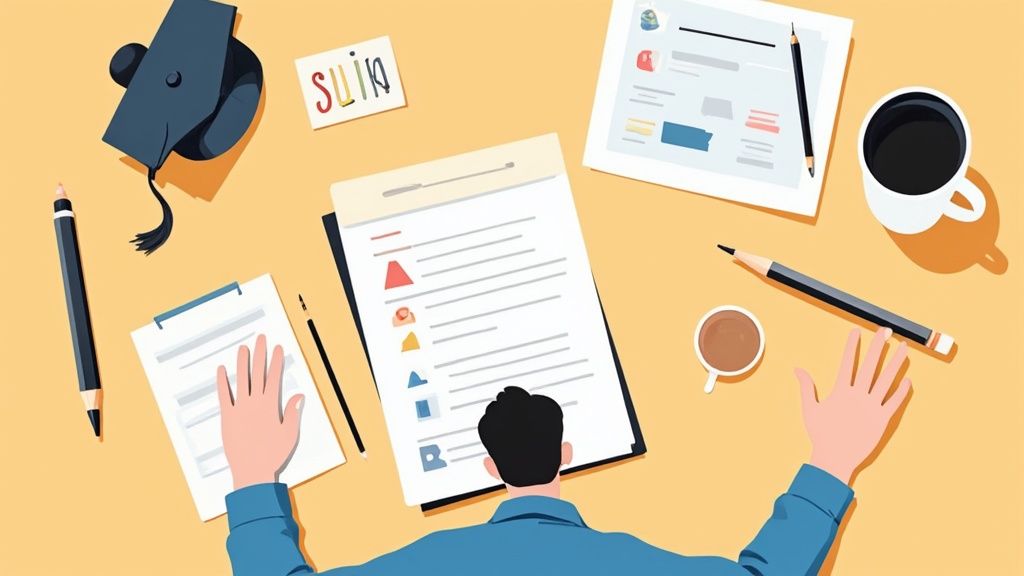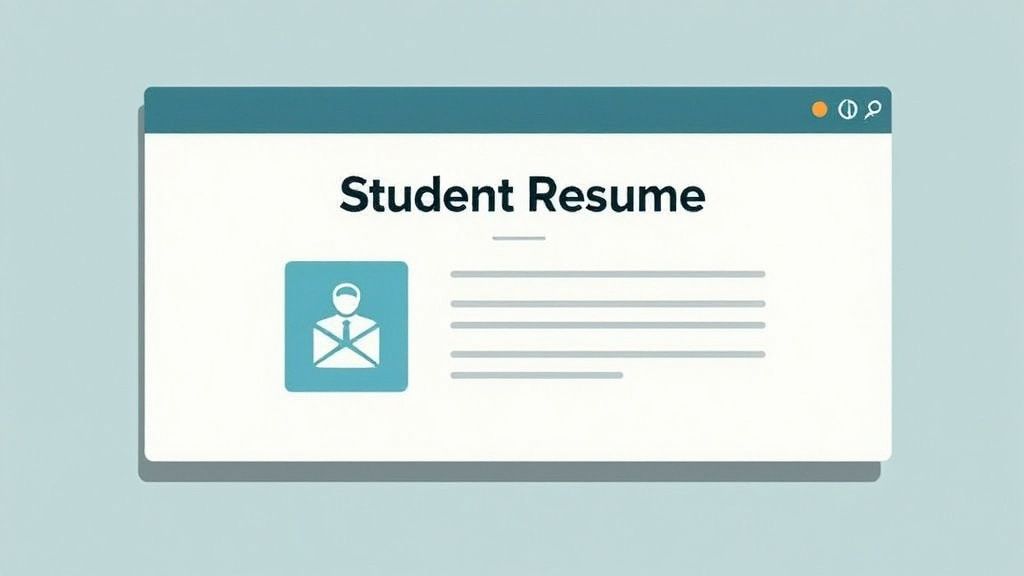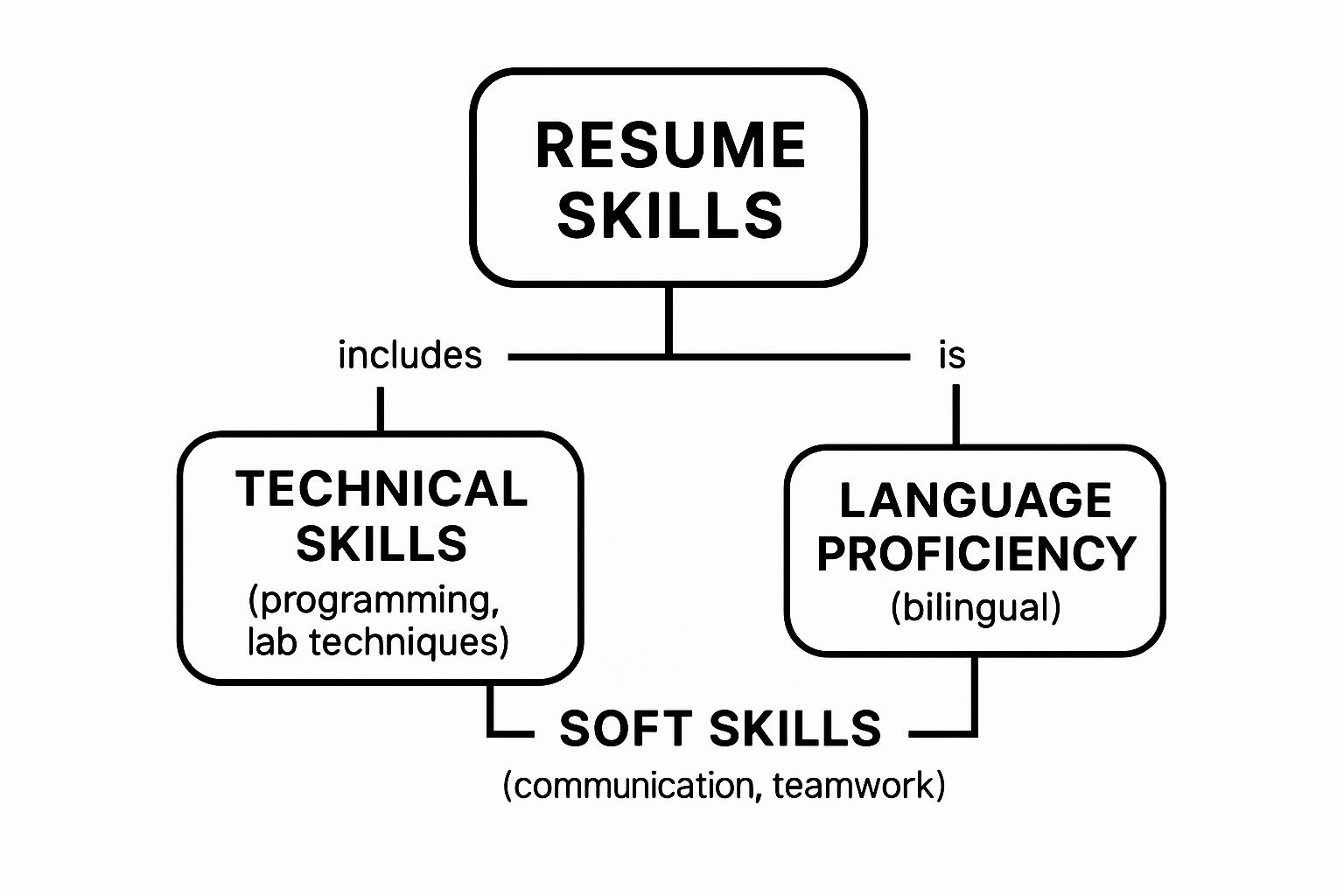
How to Write a Student Resume - Tips to Stand Out
As a student, your resume isn’t just a list of past jobs—it’s a showcase of your potential. The trick is to shine a spotlight on what you do have: your education, relevant projects, and the valuable skills you’ve picked up from things like volunteer work or campus clubs. This is how you prove your worth, even if you don’t have a long professional history to draw from.
Why Your Student Resume Matters More Than Ever
Think of your student resume as your number one marketing tool in a seriously crowded field. It’s a one-page ad for your ambition, your skills, and what you’re capable of becoming. In today’s competitive market for entry-level roles, this document is often the only thing a recruiter sees before deciding whether to give you a chance or toss your application into the “no” pile. A generic resume that just lists what you did at a summer job simply won’t cut it anymore.
The Challenge Facing Students Today
Let’s be real: landing internships and first jobs is incredibly tough. Not long ago, employers were getting an average of 140 applications for a single graduate role—that’s a massive 59% jump from previous years. With that kind of volume, it’s no surprise that fewer than 3% of resumes submitted actually lead to an interview. You can discover more insights about resume success rates) and learn how to beat those odds.
This intense competition means your resume has to do some heavy lifting. It needs to:
-
Get Past the Robots: Many companies use Applicant Tracking Systems (ATS) to pre-screen resumes. If your formatting is off or you lack the right keywords, a human will never even see it.
-
Make an Instant Impression: When a real person finally sees your resume, they’ll likely spend just a few seconds on it. A clean, scannable layout is absolutely essential.
-
Show What You’re Capable Of: For students, a resume is all about potential. You have to connect the dots for the employer by highlighting relevant coursework, projects, and skills that show you’re ready for the job.
Your resume is your first impression, your handshake, and your elevator pitch all rolled into one. It’s the critical first step in proving you’re a candidate worth investing in.
Before we dive into the nuts and bolts, here’s a quick overview of what makes a student resume truly effective.
Quick Guide to an Effective Student Resume
This table breaks down the essential sections and explains why each one is so important for capturing an employer’s attention when you’re just starting out.
| Resume Section | What to Include | Why It Matters for Students |
|---|---|---|
| Contact Info | Full Name, Phone Number, Professional Email, LinkedIn URL, and optional Portfolio link. | Makes it easy for recruiters to contact you. A professional presence (like a complete LinkedIn) shows you’re serious. |
| Summary/Objective | A brief 2-3 sentence pitch highlighting your career goals and key qualifications. | Grabs attention immediately and tells the reader who you are and what you want, setting the stage for the rest of the resume. |
| Education | University, Degree, Major/Minor, GPA (if 3.5+), and expected graduation date. | This is often your strongest asset. Placing it near the top emphasizes your most relevant and recent qualifications. |
| Projects | Academic, personal, or group projects. Describe the project, your role, and the outcome. | Demonstrates practical application of your skills, problem-solving ability, and initiative beyond coursework. |
| Experience | Internships, part-time jobs, volunteer work, or leadership roles in clubs. | Shows responsibility, work ethic, and transferable skills like communication, teamwork, and time management. |
| Skills | Hard skills (e.g., Python, Adobe Creative Suite) and relevant soft skills. | Provides a quick, scannable list of your capabilities and helps your resume pass through ATS keyword filters. |
Ultimately, knowing how to write a great student resume is about learning to tell a compelling story about your professional promise using the experiences you already have.
Building the Core of Your Resume
Every strong student resume is built on four key pillars. Think of these as the foundation. Each one has a specific job to do, and when they work together, they paint a clear, persuasive picture of who you are and what you can offer a potential employer. Getting these right is your first real step toward creating a resume that actually gets you interviews.

Remember, this isn’t just about listing what you’ve done. It’s about telling a strategic story. You need to frame every piece of information to showcase your potential, which is especially important when you feel like you don’t have a long professional history to draw from.
Start with Flawless Contact Information
This sounds obvious, but you’d be surprised how many people mess it up. Your contact section has to be professional and 100% error-free. A single typo here can cost you an opportunity before you even get started.
Make sure you include:
- Your full name
- A professional-sounding email (think
[email protected]) - Your phone number
- A direct link to your polished LinkedIn profile
Write a Compelling Professional Summary
Please, skip the outdated “Objective” statement. Nobody uses those anymore. Instead, lead with a short, powerful professional summary—just two or three sentences is all you need. This is your elevator pitch right at the top of the page, grabbing the reader’s attention by highlighting your drive, top skills, and what you’re looking to accomplish.
Here’s a great example for a marketing student:
“A creative and data-driven marketing student with experience in social media content creation and campaign analysis from academic projects. Eager to apply skills in digital analytics and content strategy to help drive brand engagement in an internship role.”
See how that immediately tells the recruiter who you are and what value you bring? It sets the stage for the rest of your resume, making a much stronger first impression. Honestly, a well-written introduction is one of the most critical components of a resume because it frames everything that comes after.
Maximize Your Education Section
As a student, your education is one of your strongest selling points, so don’t just list your university and graduation date. Make this section work harder for you. Go beyond the basics and add some detail.
Consider including:
- Relevant Coursework: List specific classes that align with the job you want.
- Academic Projects: Briefly describe major projects that prove you can apply what you’ve learned.
- Honors and Awards: If you made the Dean’s List or won a scholarship, show it off.
- GPA: My rule of thumb? Only include it if it’s a 3.5 or higher.
Adding these details shows you’re not just a passive student; you’ve already started building a solid knowledge base in your field.
Frame Your Experience Strategically
This is the section where most students get stuck, but it’s all about how you frame it. Your experience isn’t just about paid, full-time jobs. You have to think bigger.
Pull from internships, part-time work, volunteer positions, and even leadership roles you held in campus clubs. The trick is to focus on the transferable skills you gained in each role—things like communication, problem-solving, and teamwork. That’s what employers are really looking for.
Turning Your Experience into Real Accomplishments
One of the most common mistakes I see on student resumes is a simple list of job duties. Recruiters already know what an intern does; they want to know what you accomplished. This shift in perspective—from responsibilities to results—is the single most powerful way to make your experience pop, whether it’s from an internship, a campus club, or even a personal project.
Think about it. Anyone can write “Helped with social media.” It’s a passive statement that doesn’t tell a hiring manager much at all.
What if you framed it this way instead?
- Instead of: Helped with social media.
- Try this: Increased Instagram engagement by 25% over three months by launching a student-focused content series.
See the difference? You’ve gone from being a passive helper to an active achiever. Use numbers, percentages, and specific outcomes whenever you can. It paints a vivid picture of the value you bring to the table.
Let Your Skills Shine—Both Hard and Soft
As you write out your accomplishments, you’ll naturally start highlighting your skills. But it’s still smart to create a dedicated skills section. It makes your resume easier to scan and helps it get past those automated Applicant Tracking Systems (ATS). This is your chance to clearly separate your technical know-how from your interpersonal strengths.
The focus on soft skills has skyrocketed recently. A staggering 86% of employers now say problem-solving abilities are more important than traditional metrics like GPA. Things like internships, volunteer work, and leadership roles are some of the first things they look for. Your resume needs to show you’ve got these skills in spades.
Your resume isn’t just a list of jobs; it’s a story about what you’re capable of. When you turn duties into measurable achievements, you give employers concrete proof of your potential.
This is also a great opportunity to connect your experiences directly to what the company is asking for in their job posting. For a more in-depth look at this, our guide on how to tailor a resume to a job description is a fantastic resource.
When you build out your skills section, keep it organized and easy to read.
- Technical Skills: Get specific. List the software, programming languages, or tools you know, like Python, Adobe Creative Suite, or Canva.
- Soft Skills: These are your people skills. Think Teamwork, Communication, Problem-Solving, and Adaptability.
- Languages: If you speak another language, add it here with your proficiency level (e.g., Spanish - Conversational).
Formatting Your Resume for Humans and Robots
Here’s a hard truth: before your resume ever lands in front of a hiring manager, it has to get past the robots. I’m talking about the Applicant Tracking System (ATS), the software that stands between you and your first interview. Staggeringly, over 70% of resumes get filtered out by an ATS before a human ever lays eyes on them.
This means your resume has to do double duty. It needs to be simple enough for the software to read, but also compelling enough for a human to actually want to read.
So, how do you do that? For the ATS, stick to the basics. Use standard fonts like Arial or Calibri, and use clear, universally understood headings like “Work Experience” and “Education.” Ditch the fancy tables, columns, and graphics—they often confuse the software and can get your application tossed out.
Once you’ve cleared the digital hurdle, your resume has about seven seconds to grab a recruiter’s attention. That’s it. A clean, scannable design is no longer a “nice-to-have”; it’s a necessity.
Keep It Clean and Scannable
You want to make a recruiter’s job as easy as possible. A well-organized layout is your best friend here.
A few tips from my experience:
- Pick a Professional Font: Stick with something clean and easy to read. A font size between 10-12 points for the main text and 14-16 points for your headings is the sweet spot.
- Embrace White Space: One-inch margins are your baseline. Adding a little extra space between sections creates breathing room and helps guide the reader’s eye right to the important stuff. It makes the entire document feel less intimidating.
- Always Send a PDF: Unless the application specifically asks for a Word document, a PDF is the way to go. It locks in your formatting, so what you see on your screen is exactly what the recruiter sees on theirs. If you’re on the fence, you can learn more about choosing the best resume format.
This visual guide shows how to break down your skills so they’re easy to spot at a glance.

As you can see, organizing your abilities into distinct groups—like technical, soft, and language skills—makes it incredibly simple for someone to quickly assess what you bring to the table.
Resume Formatting Do’s and Don’ts
Formatting mistakes are some of the easiest to avoid, yet they’re also some of the most common reasons a resume gets rejected. This quick-reference table breaks down the essentials.
| Formatting Element | Do This | Don’t Do This |
|---|---|---|
| Font | Use a clean, standard font (e.g., Arial, Calibri, Helvetica) between 10-12 pt. | Use script, decorative, or overly stylized fonts that are hard to read. |
| Margins | Keep them between 0.5 and 1 inch to create balanced white space. | Shrink margins too much, creating a dense, overwhelming wall of text. |
| Headings | Use clear, common section titles like “Experience” and “Skills.” | Get creative with headings like “My Journey” or “Things I’m Good At.” |
| File Format | Save and submit as a PDF to preserve your layout perfectly. | Use a .docx file unless explicitly required, as it can look different on other devices. |
| Design | Stick to a simple, single-column layout for ATS compatibility. | Add tables, columns, images, or graphics that can confuse parsing software. |
Ultimately, a smart format is the silent partner to your impressive content. It’s the invisible framework that ensures all your hard work gets the attention it deserves from both the software and the people you want to work for.
Using AI Resume Tools the Smart Way
AI resume builders have popped up everywhere, and they can be a huge help. Think of them as a brainstorming partner—a great way to find stronger action verbs or figure out how to frame your skills for a specific job description. They can definitely get you started.
But here’s the catch: leaning on them too much can backfire. In 2024, it was estimated that at least 60% of resumes were written with some kind of AI help. That created a new problem for hiring managers. Suddenly, tons of applications started sounding identical, making it incredibly difficult to see who the truly standout candidates were.

Keep Your Resume Authentic
The real secret is finding the right balance. Let the AI give you a starting point, but then it’s your job to weave in your own personality and specific achievements. Trust me, recruiters can spot those generic, AI-generated phrases from a mile away, and they often read as uninspired.
Your goal is to use technology to refine and elevate your story, not to let it write a generic one for you. Ensure the final document sounds like an authentic, motivated student—not an algorithm.
Here’s how you can use these tools without losing your voice:
- Generate Ideas, Then Personalize: Try asking an AI tool for five different ways to describe your project management experience. Take the one you like best and rewrite it, injecting details from a project you actually worked on. What was the budget? What was the outcome?
- Review and Refine Every Word: Never, ever just copy and paste. Read every sentence out loud. Does it sound like you? Is it completely accurate? Adjust the tone and wording until it feels authentic.
- Focus on What Makes You Unique: An AI doesn’t know about that one specific challenge you overcame or the lightbulb moment you had during a class project. These are the details that make your story compelling. You have to add those in yourself to truly make your accomplishments shine.
Answering Your Top Student Resume Questions
Writing your first resume can feel like you’re trying to follow a bunch of unwritten rules. Don’t worry, it’s a common feeling. Let’s clear up some of the biggest questions students have so you can build your resume with confidence.
How Long Should My Resume Be?
One page. That’s the golden rule for students and new grads.
Think of it this way: recruiters are swamped. They spend just a few seconds on each resume, so a single, powerful page that gets straight to the point is your best bet. This forces you to be ruthless and focus only on what truly matters for the job you want.
The only exception? If you have years of highly relevant experience, like multiple, long-term internships in your exact field or significant published research. But for 99% of students, one page is the way to go.
But What if I Don’t Have Any “Real” Work Experience?
This is the most common hurdle, and the solution is to broaden your definition of “experience.” It’s not just about paid jobs. Employers want to see what you can do, and you’ve likely done plenty.
Your experience section can and should include:
- Major academic projects (especially group projects)
- Volunteer work
- Leadership roles in clubs or on campus
- Personal projects that showcase your skills (like a website you built or a marketing plan for a campus event)
The trick is to describe these experiences just like you would a job. Use action verbs to highlight your accomplishments and show off those transferable skills—like teamwork, problem-solving, and time management—that every employer is looking for.
Don’t let a lack of formal job titles hold you back. Your projects, volunteer work, and leadership roles are valid experiences that prove your potential and work ethic.
Should I Put My GPA on My Resume?
Here’s a simple guideline: if your GPA is a 3.5 or higher, go ahead and include it in your education section. If it’s lower than that, it’s usually best to leave it off unless the job application specifically asks for it.
More and more, companies are realizing that skills and hands-on experience are better predictors of success than grades alone. So, while a high GPA can be a nice bonus, a lower one won’t necessarily knock you out of the running if the rest of your resume is strong.
What’s the Best File Format to Use?
Always, always, always save and send your resume as a PDF.
A PDF locks in your formatting, ensuring that the beautiful document you spent hours perfecting looks exactly the same on the recruiter’s screen as it does on yours. It’s professional and prevents any weird formatting glitches that can happen with Word documents.
The only time you should ever send a .doc or .docx file is if the application system explicitly asks for it. Some older Applicant Tracking Systems (ATS) can be picky, but PDF is the industry standard.
Ready to stop wrestling with formatting and start landing interviews? Jobcamp uses AI to instantly create customized resumes and cover letters that get noticed. Upload your resume, paste a job link, and let our ATS-optimized templates do the hard work for you. Try it now at Jobcamp.ai.

